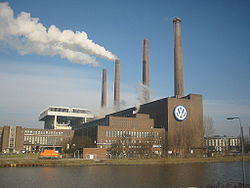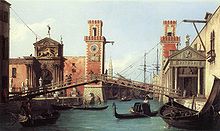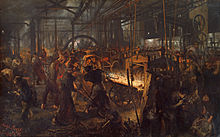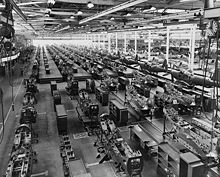- Factory
-
This article is about manufacturing plants and different kinds of factories. For other uses, see Factory (disambiguation).
A factory (previously manufactory) or manufacturing plant is an industrial building where laborers manufacture goods or supervise machines processing one product into another. Most modern factories have large warehouses or warehouse-like facilities that contain heavy equipment used for assembly line production. Typically, factories gather and concentrate resources: laborers, capital and plant.
Contents
History
The oldest known production facility that might be called a factory was discovered at Blombos Cave, a cave on the south coast of South Africa some 200 miles (320 km) east of Cape Town, where 100,000-year-old tools and ingredients were found with which early modern humans mixed an ochre-based paint.[1] Although large mills and workshops were established in ancient China, Rome and the Middle East, the Venice Arsenal provides one of the first examples of a factory in the modern sense of the word. Founded in 1104 in Venice, Republic of Venice, several hundred years before the Industrial Revolution, it mass-produced ships on assembly lines using manufactured parts. The Venice Arsenal apparently produced nearly one ship every day and, at its height, employed 16,000 people.[verification needed]
Industrial Revolution
Many historians regard Matthew Boulton's Soho Manufactory (established in 1761 in Birmingham) as the first modern factory. (Other claims might be made for John Lombe's silk mill in Derby (1721), or Richard Arkwright's Cromford Mill (1771)—purpose built to fit the equipment it held and taking the material through the various manufacturing processes.) One historian, Jack Weatherford, contends that the first factory was in Potosí, for processing silver ingot slugs into coins, because there was so much silver being mined close by.[2] See City and Factory Life for more background concerning factory conditions.
British colonies in the late 18th century built factories simply as buildings where a large number of laborers gathered to perform hand labor, usually in textile production. This proved more efficient—for administration and for the distribution of raw materials to individual laborers—than earlier methods of manufacturing such as cottage industries or the putting-out system.[verification needed]
Cotton mills used inventions such as the steam engine and the power loom to pioneer the industrial factory of the 19th century, where precision machine tools and replaceable parts allowed greater efficiency and less waste.[verification needed]
Between 1820 and 1850, the non-mechanized factories supplanted the traditional artisan shops as the predominant form of manufacturing institution. Even though the theory on why and how the non-mechanized factories gradually replaced the small artisan shops is still ambiguous, what is apparent is that the larger-scale factories enjoyed technological gains and advance in efficiency over the small artisan shops.[verification needed] In fact, the larger scale forms of factory establishments were more favorable and advantageous over the small artisan shops in terms of competition for survival.[verification needed]
New England factories in the 19th century
In New England in the early to mid-19th century, many cotton and textile factories employed large numbers of female adolescent laborers from the New England area.[3] The girls came from families of middling farmers. Factory employment offered an alternative to rural lifestyle, and many women labored, not only to send money back home, but to gain greater social & economic independence. They were able to earn enough at the factory to cover their living expenses and still have spending money and savings for dowries.[4]
In 1834 New England textile factory owners decided to cut the wages of these young women in order to save money.[5] In response, the young factory laborers organized turnouts (strikes) in an attempt to force their employers to raise wages again. These young women viewed themselves as equals to their managers. They saw their wage reductions as attempts to take away their economic independence and force them to become completely dependent upon factory employment for survival—to make them "slaves" to their employers. Because of bad timing and poor organization their 1834 factory turnout was unsuccessful, but it did lay the foundation for successful strikes that helped shape factory life in the future.[6]
20th century
Henry Ford further revolutionized the factory concept in the early 20th century, with the innovation of the mass production. Highly specialized laborers situated alongside a series of rolling ramps would build up a product such as (in Ford's case) an automobile. This concept dramatically decreased production costs for virtually all manufactured goods and brought about the age of consumerism.[verification needed]
In the mid- to late 20th century, industrialized countries introduced next-generation factories with two improvements:
- Advanced statistical methods of quality control, pioneered by the American mathematician William Edwards Deming, whom his home country initially ignored. Quality control turned Japanese factories into world leaders in cost-effectiveness and production quality.
- Industrial robots on the factory floor, introduced in the late 1970s. These computer-controlled welding arms and grippers could perform simple tasks such as attaching a car door quickly and flawlessly 24 hours a day. This too cut costs and improved speed.
Some speculation[citation needed] as to the future of the factory includes scenarios with rapid prototyping, nanotechnology, and orbital zero-gravity facilities.
Siting the factory
Before the advent of mass transportation, factories' needs for ever-greater concentrations of laborers meant that they typically grew up in an urban setting or fostered their own urbanization. Industrial slums developed, and reinforced their own development through the interactions between factories, as when one factory's output or waste-product became the raw materials of another factory (preferably nearby). Canals and railways grew as factories spread, each clustering around sources of cheap energy, available materials and/or mass markets. The exception proved the rule: even greenfield factory sites such as Bournville, founded in a rural setting, developed its own housing and profited from convenient communications systems.[verification needed]
Regulation curbed some of the worst excesses of industrialization's factory-based society, a series of Factory Acts leading the way in Britain. Trams, automobiles and town planning encouraged the separate development of industrial suburbs and residential suburbs, with laborers commuting between them.
Though factories dominated the Industrial Era, the growth in the service sector eventually began to dethrone them:[verification needed] the focus of labor in general shifted to central-city office towers or to semi-rural campus-style establishments, and many factories stood deserted in local rust belts.
The next blow to the traditional factories came from globalization. Manufacturing processes (or their logical successors, assembly plants) in the late 20th century re-focussed in many instances on Special Economic Zones in developing countries or on maquiladoras just across the national boundaries of industrialized states. Further re-location to the least industrialized nations appears possible as the benefits of out-sourcing and the lessons of flexible location apply in the future.[verification needed]
Governing the factory
Much of management theory developed in response to the need to control factory processes.[verification needed] Assumptions on the hierarchies of unskilled, semi-skilled and skilled laborers and their supervisors and managers still linger on; however an example of a more contemporary approach to handle design applicable to manufacturing facilities can be found in Socio-Technical Systems (STS).
Shadow factories
A shadow factory is a term given to dispersed manufacturing sites in times of war to reduce the risk of disruption due to enemy air-raids and often with the dual purpose of increasing manufacturing capacity. Before World War II Britain had built many shadow factories.
British shadow factories
Production of the Supermarine Spitfire at its parent company's base at Woolston, Southampton was vulnerable to enemy attack as a high profile target and was well within range of Luftwaffe bombers. Indeed on 26 September 1940 this facility was completely destroyed by an enemy bombing raid. Supermarine had already established a plant at Castle Bromwich; this action prompted them to further disperse Spitfire production around the country with many premises being requisitioned by the British Government.[7]
Connected to the Spitfire was production of its equally important Rolls-Royce Merlin engine, Rolls-Royce's main aero engine facility was located at Derby, the need for increased output was met by building new factories in Crewe and Glasgow and using a purpose-built factory of Ford of Britain in Trafford Park Manchester.[8]
See also
- British shadow factories
- Factory farm
- Industrial railway
- Industrial Revolution
- List of production topics
- Manufacturing
- Plant layout study
- Software factory
Notes
- ^ John Noble Wilford (October 13, 2011). "In African Cave, Signs of an Ancient Paint Factory". The New York Times. http://www.nytimes.com/2011/10/14/science/14paint.html. Retrieved 2011-10-14.
- ^ Weatherford, Jack (1988). Indian Givers: How the Indians of the Americas Transformed the World. The Random House Publishing Group. ISBN 0-449-90496-2.
- ^ Thomas Dublin, Transforming Women’s Work: New England Lives in the Industrial Revolution (Ithaca and London: Cornell University Press, 1995), 77, 118.
- ^ Thomas, Dublin(1995). "Transforming Women’s Work page: New England Lives in the Industrial Revolution 77, 118" Cornell University Press.
- ^ Thomas Dublin, Women at Work: The Transformation of Work and Community in Lowell, Massachusetts, 1826–1860 (New York: Columbia University Press, 1981), 86–107.
- ^ Thomas, Dublin(1981) "Women at Work: The Transformation of Work and Community in Lowell, Massachusetts, 1826–1860: Page 86–107" New York: Columbia University Press.
- ^ Price 1986, p. 115.
- ^ Pugh 2000, pp. 192-198.
References
- Needham, Joseph (1986). Science and Civilization in China: Volume 5, Part 1. Taipei: Caves Books, Ltd.
- Thomas, Dublin(1995). "Transforming Women’s Work page: New England Lives in the Industrial Revolution 77, 118" Cornell University Press.
- Price, Alfred. The Spitfire Story: Second edition. London: Arms and Armour Press Ltd., 1986. ISBN 0-85368-861-3.
- Pugh, Peter. The Magic of a Name — The Rolls-Royce Story — The First 40 Years. Cambridge, England. Icon Books Ltd, 2000. ISBN 1-84046-151-9
- Thomas, Dublin(1981). "Women at Work: The Transformation of Work and Community in Lowell, Massachusetts, 1826–1860: Page 86–107" New York: Columbia University Press.
- Biggs, Lindy (1996). The rational factory: architecture, technology, and work in America's age of mass production. Johns Hopkins University Press. ISBN 9780801852619.
Further reading
- Christian, Gallope, D (1987) 'Are the classical management functions useful in describing managerial processes?' Academy of Management Review. v 12 n 1, p38–51.
- Peterson, T (2004) 'Ongoing legacy of R.L. Katz: an updated typology of management skills', Management Decision. v 42 n10, p1297–1308.
- Mintzberg, H (1975) 'The manager's job: Folklore and fact' , Harvard Business Review, v 53 n 4, July – August, p49–61.
- Hales, C (1999) 'Why do managers do what they do? Reconciling evidence and theory in accounts of managerial processes', British Journal of Management, v 10 n4, p335–350.
- Mintzberg, H (1994) 'Rounding out the Managers job', Sloan Management Review, v 36 n 1 p 11–26.
- Rodrigues, C (2001) 'Fayol’s 14 principles then and now: A plan for managing today’s organizations effectively', Management Decision, v 39 n10, p 880–889
- Twomey, D. F. (2006) 'Designed emergence as a path to enterprise', Emergence, Complexity & Organization, Vol. 8 Issue 3, p12–23.
- McDonald, G (2000) Business ethics: practical proposals for organisations Journal of Business Ethics. v 25(2) p 169–185
External links
Aspects of workplaces See also: template Aspects of corporations · template Aspects of occupations · template Aspects of organizations · template Employment · Corporation · Employment · Factory · Office · Organization · WhistleblowerAbsenteeism · Aggression · Bullying · Conflict · Control freak · Counterproductive behavior · Coworker backstabbing · Cyber-aggression · Democracy · Deviance · Discrimination · Diversity · Emotion · Employee silence · Employee surveys · Empowerment · Evaluation · Feminisation · Friendship · Gender inequality · Gossip · Happiness · Harassment · Health surveillance · Humor · Incivility · Intervention · Jargon · Listening · Micromanagement · Mobbing · Morale · Office politics · Performance appraisal · Phobia · Privacy · Probation · Profanity · Queen bee syndrome · Revenge · Sabotage · Safety · Spirituality · Staff turnover · Strategy · Stress · Surveillance · Toxic workplace · Training · Violence · WellnessCategories:- Industrial Revolution
- Manufacturing
- Production and manufacturing
Wikimedia Foundation. 2010.





